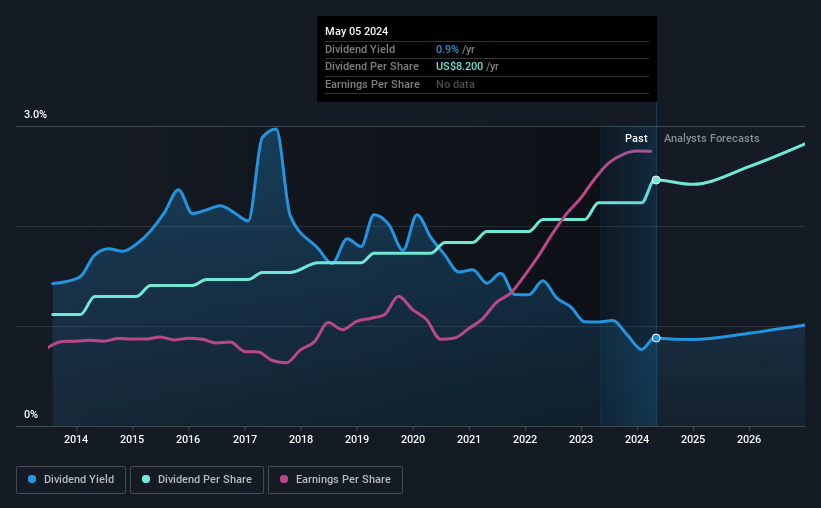W.W. Grainger, Inc. (NYSE:GWW) Looks Interesting, And It's About To Pay A Dividend
Readers hoping to buy W.W. Grainger, Inc. (NYSE:GWW) for its dividend will need to make their move shortly, as the stock is about to trade ex-dividend. Typically, the ex-dividend date is one business day before the record date which is the date on which a company determines the shareholders eligible to receive a dividend. It is important to be aware of the ex-dividend date because any trade on the stock needs to have been settled on or before the record date. Therefore, if you purchase W.W. Grainger's shares on or after the 10th of May, you won't be eligible to receive the dividend, when it is paid on the 1st of June.
The company's upcoming dividend is US$2.05 a share, following on from the last 12 months, when the company distributed a total of US$8.20 per share to shareholders. Based on the last year's worth of payments, W.W. Grainger has a trailing yield of 0.9% on the current stock price of US$931.94. Dividends are a major contributor to investment returns for long term holders, but only if the dividend continues to be paid. So we need to investigate whether W.W. Grainger can afford its dividend, and if the dividend could grow.
View our latest analysis for W.W. Grainger
Dividends are typically paid out of company income, so if a company pays out more than it earned, its dividend is usually at a higher risk of being cut. W.W. Grainger has a low and conservative payout ratio of just 20% of its income after tax. Yet cash flows are even more important than profits for assessing a dividend, so we need to see if the company generated enough cash to pay its distribution. The good news is it paid out just 22% of its free cash flow in the last year.
It's positive to see that W.W. Grainger's dividend is covered by both profits and cash flow, since this is generally a sign that the dividend is sustainable, and a lower payout ratio usually suggests a greater margin of safety before the dividend gets cut.
Click here to see the company's payout ratio, plus analyst estimates of its future dividends.
Have Earnings And Dividends Been Growing?
Companies with consistently growing earnings per share generally make the best dividend stocks, as they usually find it easier to grow dividends per share. If earnings fall far enough, the company could be forced to cut its dividend. That's why it's comforting to see W.W. Grainger's earnings have been skyrocketing, up 22% per annum for the past five years. With earnings per share growing rapidly and the company sensibly reinvesting almost all of its profits within the business, W.W. Grainger looks like a promising growth company.
The main way most investors will assess a company's dividend prospects is by checking the historical rate of dividend growth. In the past 10 years, W.W. Grainger has increased its dividend at approximately 8.2% a year on average. We're glad to see dividends rising alongside earnings over a number of years, which may be a sign the company intends to share the growth with shareholders.
Final Takeaway
From a dividend perspective, should investors buy or avoid W.W. Grainger? W.W. Grainger has been growing earnings at a rapid rate, and has a conservatively low payout ratio, implying that it is reinvesting heavily in its business; a sterling combination. There's a lot to like about W.W. Grainger, and we would prioritise taking a closer look at it.
In light of that, while W.W. Grainger has an appealing dividend, it's worth knowing the risks involved with this stock. Case in point: We've spotted 1 warning sign for W.W. Grainger you should be aware of.
Generally, we wouldn't recommend just buying the first dividend stock you see. Here's a curated list of interesting stocks that are strong dividend payers.
Have feedback on this article? Concerned about the content? Get in touch with us directly. Alternatively, email editorial-team (at) simplywallst.com.
This article by Simply Wall St is general in nature. We provide commentary based on historical data and analyst forecasts only using an unbiased methodology and our articles are not intended to be financial advice. It does not constitute a recommendation to buy or sell any stock, and does not take account of your objectives, or your financial situation. We aim to bring you long-term focused analysis driven by fundamental data. Note that our analysis may not factor in the latest price-sensitive company announcements or qualitative material. Simply Wall St has no position in any stocks mentioned.

 Yahoo Finance
Yahoo Finance 
